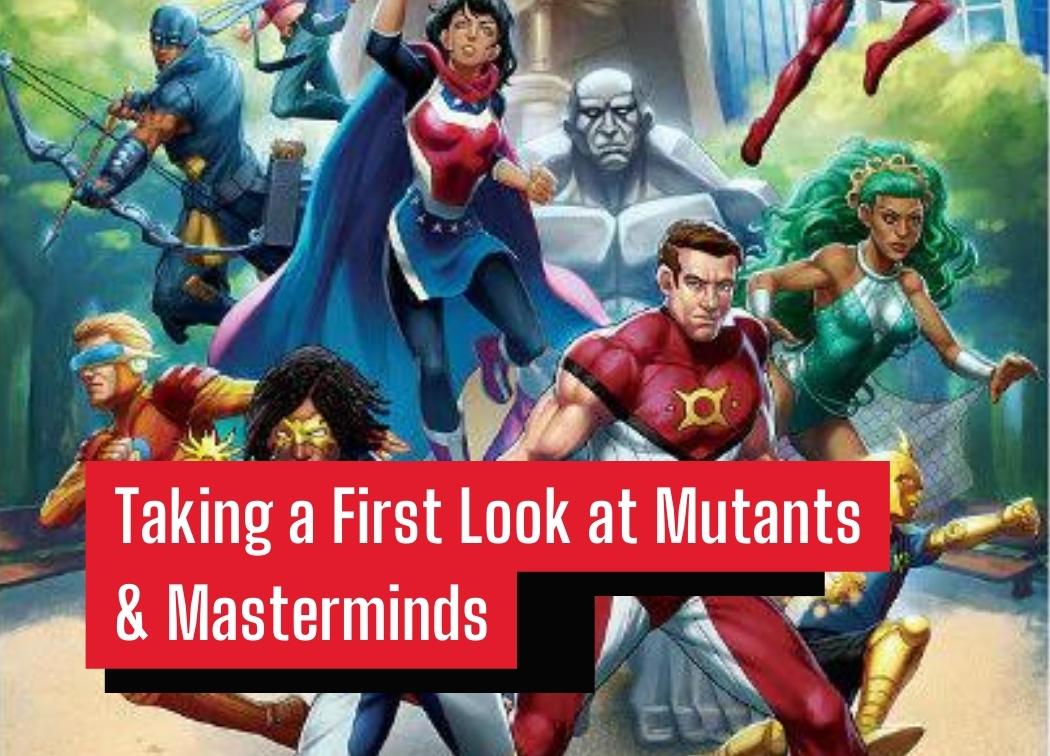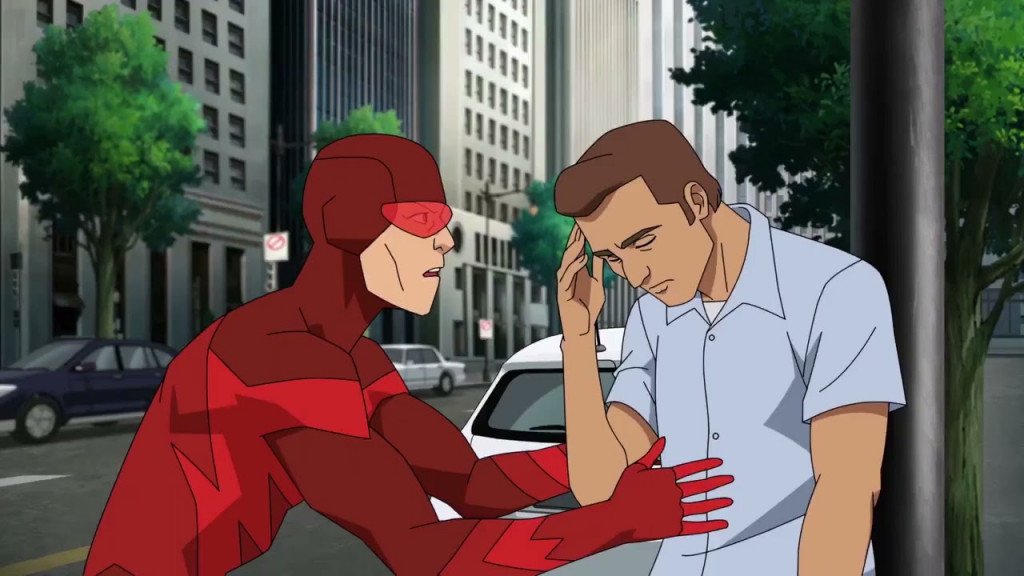Taking a First Look at Mutants & Masterminds

Whilst I plug along at my adventurer’s guild project and upcoming campaign, my buddy decided to make use of our freed-up night and run a new TTRPG system. He’s been working on a Mutants & Masterminds mini-campaign for some time now and, since I’ve heard great things about it I jumped at the chance to become a superhero.
We just had our first session, after two session 0s, and I am pumped for the rest of this campaign. This is a beefy system, but it played great and I had an absolute blast playing the speedster I built.
It’s a D20 system so of course there are some similarities to D&D, but it’s very distinct. It’s clear that from the get-go the designers had playing a genuine superhero in mind. You feel powerful right out of the gate which felt weird compared to D&D 5e’s level 1 player experience yet fitting. After all… you’re a superhero!
Let’s take a look at my initial thoughts on playing Mutants & Masterminds. Both because I really like this system and so I have a jumping-off point for the additional articles and thoughts as I play through this campaign.
Character Creation: Crunchy, but Rewarding!
Mutants & Masterminds has by far the crunchiest character creation system I’ve used in a long time. It’s essentially a point-buy system where each player character gets a certain number of points depending on what type of campaign the GM wishes to run.
Each player has the same pool of points to allocate toward their stats, but unlike D&D 5e the ability scores are not all they’re used for! You need to purchase your hero powers, advantages, skill points, and most importantly, defense stats with this power pool. It’s a complex balancing game as each player must pick and choose what they want out of their character in every facet of the game.
The two coolest facets of character creation were picking our advantages and superpowers.
Advantages are abilities that break the rules of Mutants & Masterminds. They can change how the action economy works, augment aspects of your character sheet, or give you additional ways to use different actions in the game.
For example, my character’s Move-by Action advantage allows him to move both before and after his action whereas normally you can only move before or after your action. For a superhero that can move 16,000 mph having unrestricted movement during his turn is quite valuable!

Since this is a classless system superpowers aren’t restricted to a certain type of superhero. Anyone can do anything. This is because you literally build each superpower from the ground up by combining different powers. They do have a few suggested superpowers to help showcase how this works, but you can literally do anything if you’re creative enough.
For example, my character’s Super-Speed is a combination of three different powers. Enhanced Initiative to give me higher initiative rolls, Quickness so I can perform actions/checks faster, and Speed so I can move faster.
Each power can have a separate rank based on which powers within a superpower you prefer. For instance, I have 13 ranks of Speed but only 3 ranks of Enhanced Initiative.
This whole process took each of us a few hours. Even when using the default characters as a foundation. However, speaking for myself, I think the time spent was well worth it. My speedster plays and feels exactly how I envisioned him.
Focus on the Flaws
My favorite superhero stories tend to focus or at least showcase the hero’s limitations and flaws. Mutants & Masterminds won me over quickly because it focused and rewarded including flaws when building a character.
Obviously, there are your typical role-playing flaws that come into play here. For example, my character’s first and foremost priority is saving people. I can say quite confidently that his desire to save people will be tried at some point when say confronting a villain and sacrificing people would ultimately save more lives.
This is pretty normal superhero stuff. Flaws make for interesting characters, especially super-powered ones!
There are also mechanical flaws and drawbacks that you can implement. You can add a flaw to any superpower such as having the power activate randomly or certain conditions have to be met or the power won’t work.
Adding a flaw to a power reduces the point cost for each power by 1. This means you can save yourself a bunch of points if you slap on a limitation to a power. Of course, this may mean that the power has reduced potency or it may not activate when you need it most.
I LOVE this added risk and reward element to character building and cannot wait to see how it plays out!
Initial Gameplay Thoughts
There are a lot of similarities to D&D in its gameplay. You’ve got movement (though it’s not broken-up as I mentioned previously), free actions, a reaction, and a standard action on each turn. However, it also shakes things up a bit, making the gameplay feel a lot more superhero-like rather than a typical hack and slash TTRPG.
One example of this is the Extra Effort mechanic which I adore. A character can choose to overexert themselves once per turn. When doing so they can do a variety of things such as move at a faster speed, resist a check, gain a bonus on a roll, gain an extra standard action, etc.
The cost for doing so is that you are fatigued (or exhausted/incapacitated depending on your level of fatigue) when you start your next turn.
Extra Effort is such a fantastic interpretation of a superhero pushing themselves past their limit to save someone or throw a final punch at a villain. I used it during our session to save a bunch of bystanders and it felt amazing.
There are also Hero Points which work like a well-thought-out version of D&D 5e’s Inspiration mechanic. I think that topic warrants its own article though.
TONs of Avenues Role-Play
The superhero genre is ripe with role-playing opportunities. Every superhero or villain has a motive for why they do what they do. This alone gives any player plenty of material for role-playing.
Plus, there are a variety of ways to tell a superhero story. For example, while our supers are established in our campaign, they only got their powers recently. They’ll need to learn how to use their powers as they grow into their role as the protectors of their home city.
Superheroes aren’t one-dimensional beings. A D&D adventurer is played as an adventurer. A superhero, however, has a life behind the mask. You can choose to keep your identity secret or have it be public information, but of course, there are consequences and role-playing stakes for either option.
Each person effectively plays two characters. They’re the same person, but presumably, each one has different goals and ideals that may even intersect at times.
Super Dynamic Combat
Defeating the villain is important. Especially if they’re endangering the lives of innocent bystanders. Yet, defeating a villain isn’t the sole victory condition in any superhero combat encounter.
Defeating the villain, but allowing 200 people to be unnecessarily killed by rubble from a falling building due to your skirmish isn’t much of a victory.
Damage mitigation and rescue operations are as crucial as defeating the villain to most superheroes. That’s what makes them superheroes, they go above and beyond to protect those around them. This provides multiple unique objectives to any combat encounter making each one dynamic.
For example, our first combat encounter featured a burning building, a few enemies, and a crowd of innocent people. So, we played to our strengths to solve all these issues. I used my super-speed to carry the crowd out of the danger zone, two of our bruiser-types fought the minions head-on and prevented them from chasing after any bystanders, and our weather-control hero used snow to chill the area and douse the flames preventing further destruction.
It was cool. Each of us played to our powers’ strengths and contributed to the success of the encounter.
Reactive Gameplay Elements
One of the key gameplay differences of Mutants & Masterminds compared to D&D 5e that I’ve noticed is that it’s much more reactive. You are constantly making decisions based on the enemy’s movements or the state of the environment.
For example, when the building caught fire we focused on rescuing the bystanders. However, when the minions popped up on the battlefield a couple of turns later, some of us pivoted to keep them at bay.
Yet it’s not just the state of the game that causes these decisions. The gameplay mechanics themselves lend to this style of play.
Every attack has an attack roll vs. the target’s defenses. If you hit, it’s a hit. However, unlike D&D, the target then has a chance to roll using their defenses to lessen or negate the impact of the attack. Your defenses are both passive and active.
It’s different, but I like it. It’s more engaging and feels like spending points on your defenses during character creation pays off in practice.
Conclusions
I was initially wary of the general crunchiness of the system. There was and is a lot to learn and it took us a lot more time to make our characters and figure out the system than we’d generally be willing to deal with.
However, Mutants & Masterminds genuinely feels like a game that is going to reward the time we’re spending with the system. The designers clearly spent a lot of time and effort to make a superhero game and not a TTRPG with superhero flavor.
I’m excited to see where this system takes us. Plus, getting to being a player is a welcome treat while I tinker around with our next 5e campaign!
